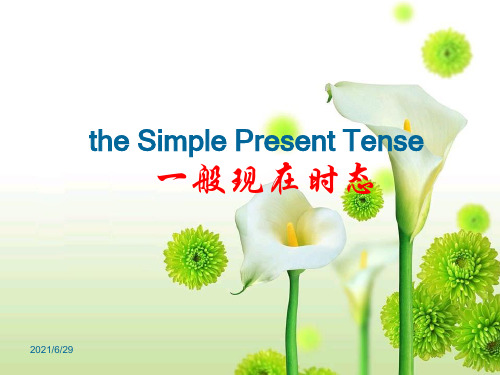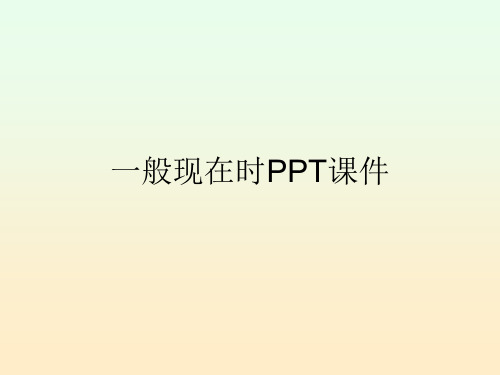动词的时态之一般现在时课件
初中英语一般现在时学习课件(共25张ppt)

一般现在时 The simple present tense
Let's chant
Like,like, what do you like? Running, running, I like running. Like, like, what does he like? Swimming, swimming, he likes swimming. Like, like, what does she like? Fishing, fishing, she likes fishing.
二、一般现在时的构成
系动词be的一般现在时 实义(行为)动词的一 般现在时
• (一)、系动词be的一般现在时
1、肯定句的构成: 主语 + be + 其他
The girl is my friend.
2.be动词包括哪些 ?
am is are 什么时候用is? 什么时候用am? 什么时候用are?
be 的用法口诀 我用am,你用are, is连着他,她,它; 单数名词用is, 复数名词全用are。
4. He always_______(wash) clothes at 7:00.
5. They ______ (watch) TV on Sundays.
6. Miss Li_______ (teach) Chinese. 1. Look at the animal, it ____(have) four legs.
Exercise
• • • • • • • 1、Kitty ( ) an English girl. 2、We ( ) students. 3、I ( ) from Taizhou. 4、She ( ) tall. 5、Lucy and Lily ( ) good friends. 6、Those chairs ( ) broken. 7、The bag ( ) mine.
(完整版)一般现在时课件

一般疑问句: Be+主语+表语?
Are your parents doctors? Yes, they are./No, they aren’t. Is Mr Long 28 years old? Yes, he is./No, he isn’t.
2021:表示行为动作的词语
3. 经常、习惯、反复做的事情 We have lunch at 12:30. We go to school on Monday.
2021/6/29
be 动词的一般现在时:
be: am, is, are
用be动词的适当形式填空: I ‗a‗m‗‗ he‗‗is‗‗ she ‗i‗s‗‗
iti‗s‗‗‗ Tomis‗‗‗‗
否定句:
☺主语(I/We/You/They)+do+ not+动词原形+其他 I don’t watch TV on Sunday. ☺主语(He/She/It)+does +not+动词原形+其他 He doesn’t watch TV at home on Sunday.
2021/6/29
Practice:
5. 特殊情况 have– has
把下面的行为动词变为第三人称单数形式:
go―goes
carry―carries ride―rides
open―opens
have ― has
teach―teaches brush― brushes dey―deys
play―plays
finish―finishes
2021/6/29
1.一般情况直接加s e.g. reads, plays, works, makes
一般现在时ppt课件完整版

不可数名词作主语时,谓语动词用单数 形式。
可数名词单数作主语时,谓语动词也用 单数形式。
例如:Water is essential for life.(水 对生命至关重要。)/ A book is on the table.(一本书在桌子上。)
例外情况总结
当主语为并列主语时,谓语动词的数要与靠近它的主语保持一致。
练习3答案
reads。解析:主语 She 是第三人称单数 ,且时间状语为 on weekends,表示经 常性动作,所以谓语动词要用单数形式 reads。
THANKS
时间状语分类及举例
表示经常性或习惯性的动作
always, usually, often, sometimes
表示现在的状态或特征
now, at present, these days
表示普遍真理或客观事实
in general, as a rule
频率副词分类及举例
01
高频副词
always, constantly, continually
注意区分完全否定和部分否定。完全 否定表示全部否定,而部分否定表示 部分否定。例如,“None of the students passed the exam.”(没 有一个学生通过了考试)是完全否定 ;“Not all of the students passed the exam.”(并非所有学生都通过 了考试)是部分否定。
does he work?等。
动词短语和情态动词的变化规则
03
动词短语中的动词和情态动词后接动词原形,如I can swim,
they often go out等。
02 肯定句结构与用法
主语+动词原形+其他成分
(完整版)一般现在时PPT课件.ppt

7. Tom can not walk fast because he _c_a_r_r_ie_s(carry) a heavy box.
用动词的适当形式填空
1.She ____(go) to school at eight o’clock.
2. He usually _____ up at 17:00.(get )
直接加s
Fly-flies;ห้องสมุดไป่ตู้stay-stays
• 第三节 • 特殊疑问句
• I clean the window at home on Saturdays.
• 1、对主语提问:
• Who cleans the window at home on Saturdays?
• 2、对宾语提问:
Has David got a goal?
7. We have four lessons.(否定句) We don’t have four lessons.
8. Nancy doesn’t run fast (肯定句)
Nancy runs fast. 9. My dog runs fast. 否定句:My dog doesn’t run fast.
5. Danny_s_t_u_d_ie_s__(study) English, Chinese, Maths, Science and Art at school.
6. Mike sometimes g_o__e_s_(go) to the park with his sister.
7. At eight at night, she w__a_tc_hes (watch) TV with his parents. 8. _D_o_e_s_ Mike r_e_a_d_(read) English every day?
一般现在时课件ppt

形式
动词采用一般现在时形式 ,即动词原型或第三人称 单数形式。
一般现在时的特点
普遍性
一般现在时适用于描述普 遍存在的现象、事实或习 惯性动作。
客观性
一般现在时强调动作或状 态的客观存在,不受时间 限制。
习惯性
一般现在时用于描述习惯 性、规律性的动作或状态 。
一般现在时的用法
描述现在的动作和状态
描述普遍存在的现象和事实
选择题练习
总结词
选择题练习是一种常见的练习方式,通过提供多个选项,让学生根据语境选择正 确的答案,进一步巩固一般现在时的用法。
详细描述
在选择题练习中,教师可设计多个选项,每个选项对应不同的动词形式。学生需 要根据句子语境,选择符合时态要求的正确答案。例如,“Do you like to ___(swim/play) in the pool?”,正确答案应为“swim”。
翻译练习
总结词
翻译练习是一种跨语的练习方式,通过将句子从一种语言翻译成另一种语言,让学生更好地理解和运用一般现 在时。
详细描述
在翻译练习中,教师可提供一些英文句子,要求学生将其翻译成中文。在翻译过程中,学生需要准确把握时态的 转换和应用,确保译文符合中文表达习惯。例如,“He ___(live) in New York.”,正确译文应为“他住在纽约 。”
详细描述:一般现在时表示动作或状态的一般情况,不 强调正在进行的动作;而现在进行时则强调正在进行的 动作或正在变化的状态。
详细描述:一般现在时通常用于描述事实、习惯或目前 的状态,而现在进行时则用于描述正在进行的动作或正 在变化的状态。
详细描述:在描述当前情况、事实或习惯时,一般现在 时更为适用;而在描述正在进行的动作或变化的状态时 ,现在进行时更为合适。
一般现在时、一般过去时和一般将来时课件(PPT31张)

Was I…. ? Was he/she/it…? Were we/you/they…? Was/Were there …? Did I/you/he/she/it/ we/ you/they work
I was not(wasn’t)…. He/She/It was not (wasn’t)…. We/You/They were not (weren’t)… There was/were not….
( C ) Alice is a nice girl. She ____ to
help others.
A. ready
B. always glad
C.is always D.is always ready
__D_o__ Sam and his friends often _p_la_y__(play) games during the morning break?
A. will meet B meet C. am waiting D wait
9. Where A___ after class today?
A. will you go B. are you go C. you are going D. you will go
10. –It’s 7 p.m. They did not eat anything .
husband or son?
-- _A___
A. Yes , she will B. Yes, she visits C. Yes, with her son D. With her son
5. There _C___ a wonderful football match tomorrow.
一般现在时PPT课件

Does Kate like singing every morning?
Lily often writes to her uncle in Canada. Does Lily often write to her uncle in
Canada?
2021
20
D. 特殊疑问句: 疑问词+一般疑问句?
2021
9
频率副词在句中的位置:
1. 频率副词用在be动词后。 It is usually hot in summer.
2. 频率副词用在实义动词前。 My father usually walks home.
3. 频率副词用在助动词与实义动词之间。 I will always love you.
like—likes get--gets
go—goes watch--watches study—studies fly--flies play—plays stay--stays have—has be--is
2021
13
Practice one
写出下列单词的第三人称单数形式 live------ __liv_e_s_____ discuss---d_i_sc_u_s_s_e_s have--- ____h_a_s__ hurry--- h_u_r_ri_e_s___ go---- _____g_o_e_s wash--- __w__a_s_h_e_s stay-------- _s_t_a_y_s____ be---___is_____ enjoy------ __e_n_jo_y_s___ collect---- _c_o_ll_e_ct_s_
2021
17
• A. 肯定句: • 主语(I/We/You/They)+动词原形+其他 • 主语(He/She/It)+动词的s形式+其他 We often play basketball in the playground. Mary studies English, Chinese at school.
一般现在时讲解课件

03 一般现在时在肯定句中应 用
陈述句结构分析
主语 + 谓语
基本句型,表示主语的动作或状态。
主语 + 谓语 + 宾语
常用句型,表示主语对宾语的动作。
主语 + 谓语 + 间接宾语 + 直接宾语
双宾语句型,表示主语给间接宾语一个直接宾语。
主语 + 谓语 + 宾语 + 宾语补足语
动词形式变化规则
第三人称单数
在一般现在时中,当主语是第三人称单数时(he/she/it/ 单数名词),谓语动词要用第三人称单数形式,即在动词 原形后加-s或-es。
规则变化
一般情况下,直接在动词后加-s,如:works,plays, lives等。
不规则变化
以s,x,ch,sh结尾的动词,在词尾加-es,如:guesses, fixes,teaches,washes等;以辅音字母+y结尾的动词, 变y为i再加-es,如:studies,tries等。
03
使用场景
一般现在时常用于描述现在或经常性的情况;过去时态则用于回忆、叙
述过去的事件或经历。
与将来时态对比分析
时态区别
一般现在时与将来时态的主要区别 在于动作发生的时间点不同,前者 表示现在或经常性的动作或状态, 后者则表示未来某个时间点或时间 段内将要发生的动作或状态。
动词形式
一般现在时动词使用原形或第三 人称单数形式;将来时态则常使 用will或be going to等结构表示 将要发生的动作。
复合宾语句型,表示主语使宾语保持某种状态或做某事。
肯定句表达功能
描述经常性或习惯性的动作
一般现在时PPT课件

一般现在时一般现在时概念:1、一般现在时通常表示经常发生的动作或存在的状态I am a pupil.We go to school every day Nancy teaches us English.I often help my mother do some washing.He always go to school on foot. Sometimes we play football on Friday afternoon.■,H112、例如表示目前的特点、状爱好。
’:We are good at English.She is insterested in music.My hobby is reading books.・3、表示客观事实、•例如:•We are in the classroom.•Tom's father is a doctor.•The weather is cold in win ter.•They usually play games on Sunday.•He does his homework every day.6/1A often(经常、常常)usually (通常)sometimes (有时)always (总是、一直)every day (每天)7/1A一般现在时的构成: Be 动词的一般现在时1•第一人称单数(1) + am 2•第三人称单数(he/she/it) + is(we/they/you) + are You are a niceboy.—A _ They are busy with their homework every day. 千 I * .. __ — 一 — —ind teacher.3•第二人称单数is a It is cloudy today.8/14名词单数用is,I am = Pm you are=you're he is = he's sheis = she z s it is =it's weare =we're-I »I •theuare =thev J reI用am» You 用are.is连着he, she, it (他她它)。
一般现在时(示范课)ppt课件精选全文

精选课件
27
• 3. Daniel enjoys playing computer games.
• (改为一般疑问句并做肯定回答)
Does Daniel enjoy playing computer games?
Yes, he does.
精选课件
28
补充:some、any
• 一般说来,some 用于肯定句中,any 用于 否定句和疑问句中 。
Change the following sentences after the models.
Model 1: I like fish. (meat) I don’t like meat.
Model 2. He likes reading. (writing) He doesn’t like writing.
改疑问句或否定句时,原句里的some要改成any
There are some books on the desk. (改为否定句)
→There aren’t any books on the desk.
→Are there any books on the desk?
精选课件
29
Why not buy some apples? 为什么不买些苹果呢?
精选课件
26
句型转换
• 1. Mr. Green comes from Shanghai. • (改为一般疑问句)
Does Mr. Green come from Shanghai?
• 2. Millie lives in a flat in Beijing. • (改为否定句)
Millie doesn’t live in a flat in Beijing.
小学一般现在时详细讲解ppt课件

构成 主语 + 行为动词 + 其他
These boys like playing football. The girl reads English every morning. 注意:当主语为第三人称单数时,
行为动词要加s或者es
什么时候加s,什么时候加es呢?
经营者提供商品或者服务有欺诈行为 的,应 当按照 消费者 的要求 增加赔 偿其受 到的损 失,增 加赔偿 的金额 为消费 者购买 商品的 价款或 接受服 务的费 用
4. You ___li_k_e__(like) fish. But he _d_o_e_s_n_’t__li_k_e_(not like) fish.
12
经营者提供商品或者服务有欺诈行为 的,应 当按照 消费者 的要求 增加赔 偿其受 到的损 失,增 加赔偿 的金额 为消费 者购买 商品的 价款或 接受服 务的费 用
经营者提供商品或者服务有欺诈行为 的,应 当按照 消费者 的要求 增加赔 偿其受 到的损 失,增 加赔偿 的金额 为消费 者购买 商品的 价款或 接受服 务的费 用
• 当主语为复数时,用助动词do构成否定 • 当主语为单数时,用助动词does构成否定
注意:don’t 和 doesn’t 之后动词一定要用原形
肯定回答:Yes,主语+be
否定回答:No,主语+be+not
注意:在回答时,主语要用相应的代词代替
经营者提供商品或者服务有欺诈行为 的,应 当按照 消费者 的要求 增加赔 偿其受 到的损 失,增 加赔偿 的金额 为消费 者购买 商品的 价款或 接受服 务的费 用
含be一般疑问句的改写
• 秘诀:一调二改三问号
- 1、下载文档前请自行甄别文档内容的完整性,平台不提供额外的编辑、内容补充、找答案等附加服务。
- 2、"仅部分预览"的文档,不可在线预览部分如存在完整性等问题,可反馈申请退款(可完整预览的文档不适用该条件!)。
- 3、如文档侵犯您的权益,请联系客服反馈,我们会尽快为您处理(人工客服工作时间:9:00-18:30)。
动词的时态之一般现在时
Contents
目
录
01 02
定义、 构成
七种用法
03
04
时间短语
05
动词变化规律
句式形式
动词的时态之一般现在时
定义
• 表示通常性、规律性、习惯性的状态或者动 作(有时间规律发生的事件)的一种时间状 态。
动词的时态之一般现在时
一般现在时的构成
• 1、主语+be动词+其他 • 2、主语+V原形(do)+其他 • 3、主语+Vs\es(does)+其他
实义动词(第一人称、二人称、三人称复 数)的一般现在时句式
•肯定句:主语(I/We/You/They)+v.+其他
eg. We study in a high school. They have a pet.
•否定句:主语(I/We/You/They)+do+ not+v.+其他
表告诉我们,人们的生活正在改善。
动词的时态之一般现在时
指示一般现在时的时间短语
• 1.频度副词: sometimes(有时), often, always(总是), usually(通 常), seldom, never(决不)
• 2. 时间副词:every day / night / week / month / year, • 3. every day/morning… • 4. on Sunday…
e.g. What is he?
• 特殊疑问词 + am/is/are + 相应的人称/ + 其他
• 特殊疑问词 + do + 人称 + 动词原形 + 其他
• What/Where/Who/When/Which/why/how/whose… + am/is/are + 相应的人称/动名词的词时态之一+般现在时其他
The earth travels round the sun. 地球绕太阳旋转。 Liquid turns into gas when it is hot enough. 足够热时,液体变为气体。 Practice makes perfect. 熟能生巧。
动词的时态之一般现在时
•用法三:现阶段的状态。常跟时间副词now连用。
e.g. He is a worker.
• 否定句:主语+be+ not+表语 thirteen.
e.g.You aren’t
• 一般疑问句:Be+主语+表语? Yes, he is./No, he isn’t.
e.g. Is he a worker?
• 特殊疑问句:疑问词+be+主语? How old are you?
动词的时态之一般现在时
• 用法六:时间、条件、方式及让步状语从句中的谓语动词是将来 的动作或状态时,用一般现在时表示。(主将从现)
• If you come, we will wait for you. 如果你来,我们就等你。 • When he gets here, the work will be finished. • 当他到这儿时,工作将做完了。 • Though he disagrees with us, he will do as we decided. • 尽管他不赞成我们当观点,他还是会按我们的决定去做。
动词的时态之一般现在时
动词变化规律
• 1、一般动词,在词尾加 s ; 如:
• work--works, live--lives, play--plays, sing-- sings.
• 2、以o, s, x, ch, sh结尾的动词词尾加 -es
• teach------ teaches,
wash----- washes.
动词的时态之一般现在时
• 用法五:表示已经计划、安排好了或时间表上所安排,并且一定 要做的事情。用于这种句型的动词主要是瞬间动词:come, go, leave, arrive, begin, start, stop, close, open等。
• The train arrives at five past eight and leaves at ten past eight. • 火车八点过五分到,八点过十分离开。 • Our class begins at 7:45. 我们的课七点四十五开始。 • The shop opens at eight o’clock. 商店八点开门。
动词的时态之一般现在时
一般现在时的七种用法
•用法一:表示经常发生的动作或存在的状态。
He often stays up late. 他常熬夜。 We go home every month. 我们每月都要回家。 I watch TV at night. 我晚上看电视。
动词的时态之一般现在时
•用法二:表示客观真理或永恒的状态。
动词的时态之一般现在时
• 用法七:在某些习惯表达法中,常用一般现在时表示已经发生过 的动作或存在的状态。
• They say Wu Dong is ill. 据说吴东病了。 • The paper says the disease is under control. 报纸上说这种病已
经得到了控制。 • The diagram tells us that people’s living is improving. 这份图
He lives in Beijing now. 他现在住在北京。 She is at home. 她在家。 They work in that factory. 他们在那家工厂工作。
动词的时态之一般现在时
• 用法四:习惯性的爱好或行为。
• I like dancing while she likes singing. 我喜欢跳舞,而她喜欢唱歌。 • We get up at six. 我们六点起床。 • He studies very hard. 他学习很刻苦
• go -----goes pass----passes fix---fixes
• 3.以辅音字母加Y 结尾的词,把Y变I 在加es
• study-----studies, fly---flies
• 特殊情况:have ----has
动词的时态之一般现在时
be 动词的一般现在时的句式:
• 肯定句:主语+be+表语(n., adj.等)
